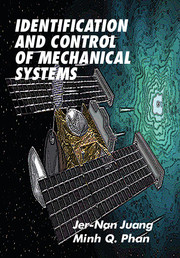Book contents
- Frontmatter
- Contents
- Preface
- 1 Ordinary Differential Equations
- 2 Elementary Matrix Algebra
- 3 Modeling Techniques
- 4 Finite-Element Method
- 5 Response of Dynamic Systems
- 6 Virtual Passive Controllers
- 7 State–Space Models
- 8 State-Feedback Control
- 9 Dynamic Feedback Controller
- 10 System Identification
- 11 Predictive Control
- Index
6 - Virtual Passive Controllers
Published online by Cambridge University Press: 02 September 2009
- Frontmatter
- Contents
- Preface
- 1 Ordinary Differential Equations
- 2 Elementary Matrix Algebra
- 3 Modeling Techniques
- 4 Finite-Element Method
- 5 Response of Dynamic Systems
- 6 Virtual Passive Controllers
- 7 State–Space Models
- 8 State-Feedback Control
- 9 Dynamic Feedback Controller
- 10 System Identification
- 11 Predictive Control
- Index
Summary
Introduction
When a mass–spring–dashpot is attached to any mechanical system, including flexible space structures, the damping of the system is almost always augmented regardless of the system size. The parameters of the mass–spring–dashpot are arbitrary, model independent, and thus insensitive to the system uncertainties. To satisfy the system performance requirements, we adjust the parameters by using the knowledge of the system model. The more the system is known, the better the parameters of the mass–spring–dashpot may be adjusted to meet the performance requirements. However, no matter what happens, the mass–spring–dashpot will not destabilize the system because it is an energy-dissipative device. The question arises as to whether there are any feedback control designs that use sensors and actuators that behave like the passive mass–spring–dashpot.
We discuss a robust controller design for flexible structures in this chapter by using a set of second-order dynamic equations similar to that describing the passive mass–spring–dashpot. Under certain realistic (practical) conditions, this method provides a stable system in the presence of system uncertainties. For better understanding, two major steps are involved in developing the formulation of the method. First, consider only the direct output feedback for simplicity, implying the absence of dynamics in the feedback controller. Conditions are identified in terms of the number and the type of sensors and their locations to make the system asymptotically stable. Second, assume that the feedback controller contains a set of second-order dynamic equations.
Information
- Type
- Chapter
- Information
- Identification and Control of Mechanical Systems , pp. 145 - 163Publisher: Cambridge University PressPrint publication year: 2001
